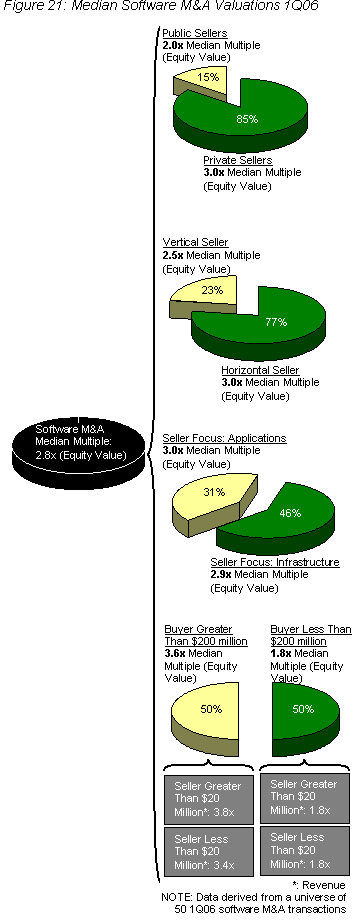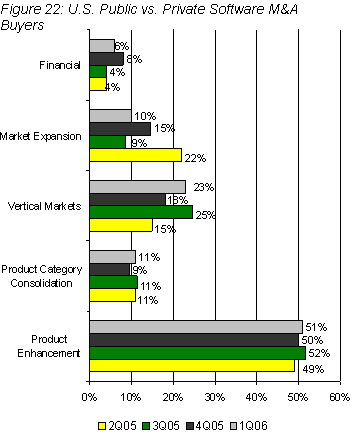|
|
| Home - Software M&A Review - May 06 Issue |
Software M&A – Q1 2006 was The Best Since '99
continued... page 5 |
 We then decided to ascertain how the current M&A market values infrastructure software companies as compared to enterprise application software companies, and analyzed the median exit valuation multiples for each category. There was little valuation disparity between the two, with application software company sellers garnering a slightly better median M&A valuation (3.0x) than infrastructure companies (2.9x). We then decided to ascertain how the current M&A market values infrastructure software companies as compared to enterprise application software companies, and analyzed the median exit valuation multiples for each category. There was little valuation disparity between the two, with application software company sellers garnering a slightly better median M&A valuation (3.0x) than infrastructure companies (2.9x).
Finally, we analyzed median exit valuations in 1Q06 based on the size (revenue) of the buyers and sellers. Simply put, size continues to have a material impact on purchase price. Buyers with revenue greater than $200 million are more likely to pay a significantly greater (possibly more than double) price than a buyer with revenues below the $200 million threshold.
The lesson of Figure 21 is for software industry buyers and sellers to be highly circumspect when applying the industry median exit valuation. Consider the following example: A private software company, looking at the median exit multiple for 1Q06 might well estimate its selling price to be 2.8x TTM revenue. But according to Figure 21, if the company is in a infrastructure category, offering a superb network security or storage management solution and generating more than $20 million in annual revenue, it could well fetch 3.7x TTM or better. Conversely, if the company has revenue of $15 million and attracts a $100 million buyer with its computer aided design tools or e-supply chain solutions, a multiple of 1.8x is far more likely in the current market. We don't anticipate this scenario will change anytime soon.
Mergers and Acquisitions: The Drivers
Were buyers in 1Q06 driven by the same motives as in prior quarters? Has buyer thinking changed? Precisely what motivated first quarter buyers to acquire this particular company; to spend cash, dilute equity, allocate precious resources and assume sometimes formidable risks? What were the deal drivers in 1Q06, how were they different from quarters past, and how did they impact valuations and purchase prices?
 Product Extension Product Extension
A deal-by-deal analysis of the 180 software transactions we analyzed in 1Q06 reveals 51% of the buyers sought to enhance their current product suite by acquiring small and mid-cap companies targeting the same markets with highly complementary, best-of-breed, market proven products and technology (Figure 22). Sellers providing such product extension leverage commanded a 3.0x TTM revenue multiple. There were a host of product extension acquisitions. Mercury Interactive acquired application integration provider Systinet to obtain a better SOA platform; BEA beefed up its SOA product offering by purchasing Fuego, a developer of best-of-breed business process management solutions; and security appliance provider Blue Coat acquired Permeo, a VPN security software company.
Market Expansion
Since 2003, we've noted a surprising number of buyers (20% in 4Q03) that venture far from home, acquiring software companies in entirely new product categories, new territories and new vertical markets in an effort to accelerate growth. The trend moderated in 2004, with market expansion acquisitions comprising about 16% of all software M&A transactions. 2005 saw the same average percentage of market expansion deals (15% in 4Q05). In 1Q06 transactions in this category declined to 10% of all deal activity and posted a median 2.8x TTM revenue multiple. Representative market expansion transactions this quarter included: Sage, a leading provider of small business accounting software, acquired Visma, an accounting software provider serving the Nordic region; BasWare, a financial software provider, strengthened its position in Finland by acquiring Anlayste; Emblaze a telecom technology provider expanded into China by picking up SenseStream, a developer of multimedia management technology; and speech recognition provider Nuance acquired Dictaphone to further expand its presence within the healthcare vertical.
|
|


|

